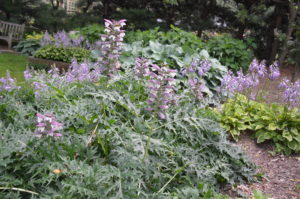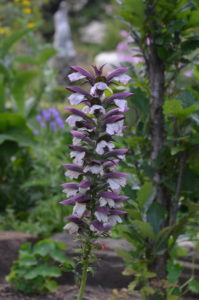Spiny bear’s breeches (Acanthus spinosa) is a clump-forming perennial treasured for its attractive thistle-like foliage and architecturally bold flower spikes (USDA hardiness zones 5b-9). Plant requires little maintenance and is long-lived. Deeply-cut, arching, glossy green, spiny, thistle-like leaves attain 2-3 feet in length on older plants and remain attractive through the growing season. Leaves bear mostly hidden spines on the tip of leaf lobes.
In late June through July (in zone 7), wands of hood-bracted flowers stand upwards of 2 feet above the dark green foliage mound. White-lipped blossoms expose purple (mauve) calyces. Foxglove–like flowers vary from white, pink or purple and attract lots of bees.
Good soil drainage is absolutely essential. Bear’s breeches is easily grown in average medium soil in full sun to part shade. The plant lingers or fails on poorly drained sites. In richly organic soil, plant mounds may reach 3-4 feet tall and wide. Plants tolerate considerable shade, but at the expense of flower numbers.
Foliage needs some afternoon shade in southern U.S. hot summers (zone 7-9). Over the years bear’s breeches will aggressively spread by underground rhizomes. Additional seedlings may pop up from the mother plant. In the early years it establishes slowly in the garden. Older clumps may be difficult to eradicate; new shoots can sprout if a small section of root is left behind.
Bear’s breeches has no serious insect or disease problems. In wet summers snails and slugs cause considerable damage to the foliage if left unchecked. The showy flowers are long lasting in cut floral arrangements. Be wary that each flower harbors a tiny sharp spine. Deer and rabbits generally stay away from this spiny plant.
Bear’s breeches (A. mollis), also indigenous to Southern Europe, bears softer spines, and is not as cold hardy as its spinier cousin (A. spinosus). Protect A. mollis from afternoon sun.



 Posted in
Posted in 
